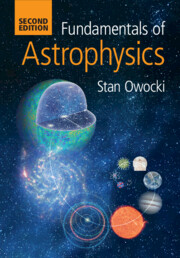
-
Select format
-
- Publisher:
- Cambridge University Press
- ISBN:
- 9781009618014
- 9781009618007
- Dimensions:
- Weight & Pages:
- Dimensions:
- (244 x 170 mm)
- Weight & Pages:
- 0.61kg, 320 Pages
You may already have access via personal or institutional login
Book description
Presenting a concise overview of astrophysical concepts, the second edition of this textbook bridges the gap between introductory astronomy books and advanced astrophysics texts. Designed for one-semester astrophysics courses, the textbook is aimed at science and engineering students with college-level calculus-based physics. The new edition features both revisions and additions, with the extension of topics such as luminosity distance and the inclusion of notable developments such as the James Webb and Roman Space Telescopes. As before, the chapters are organized into five parts, covering: stellar properties; stellar structure and evolution; the interstellar medium and star/planet formation; our Milky Way and other galaxies; and cosmology. The exposition guides students toward a comprehensive fundamental understanding, using 'Quick Questions' to spur practice in basic computations, and multi-part exercises that offer a greater challenge. The solutions to the questions are freely accessible online, with exercise solutions and lecture slides available for instructors.
Reviews
‘Owocki’s book is a welcome addition to the handful of good textbooks that cover astrophysics at an introductory level. Building on the typical first-year undergraduate STEM curriculum, he makes a thorough quantitative survey of all the important topics in stellar, galactic, and extragalactic astrophysics. Teachable within a one-semester course, this book creates an attractive technical elective in this fascinating field.’
Jim Napolitano - Temple University
‘This much-needed text fills the void for good up-to-date introductions to astrophysics for second- or third-year undergraduates with a calculus-based intro physics background. I especially like the division in short ‘one topic per session’ chapters, which makes the text useful for modern active-learning-based approaches. The exercises are well designed, and the inclusion of popular subjects such as exoplanets and gravitational wave observations will certainly inspire a broad range of students. I will seriously consider it for our Intro to Astrophysics class.’
Francesc Ferrer - Washington University in St Louis
‘Owocki's book is conversational and supremely readable. Readers will feel both the author's excitement for the material and his depth of experience explaining concepts at the undergraduate level … a welcome addition to the world of undergraduate astronomy textbooks.'
Colette Salyk - Vassar College Source: Physics Today
Contents
Metrics
Full text views
Full text views help Loading metrics...
Loading metrics...
* Views captured on Cambridge Core between #date#. This data will be updated every 24 hours.
Usage data cannot currently be displayed.
Accessibility standard: WCAG 2.2 AAA
Why this information is here
This section outlines the accessibility features of this content - including support for screen readers, full keyboard navigation and high-contrast display options. This may not be relevant for you.
Accessibility Information
The PDF of this book complies with version 2.2 of the Web Content Accessibility Guidelines (WCAG), offering more comprehensive accessibility measures for a broad range of users and attains the highest (AAA) level of WCAG compliance, optimising the user experience by meeting the most extensive accessibility guidelines.
Content Navigation
Table of contents navigation
Allows you to navigate directly to chapters, sections, or non‐text items through a linked table of contents, reducing the need for extensive scrolling.
Index navigation
Provides an interactive index, letting you go straight to where a term or subject appears in the text without manual searching.
Reading Order and Textual Equivalents
Single logical reading order
You will encounter all content (including footnotes, captions, etc.) in a clear, sequential flow, making it easier to follow with assistive tools like screen readers.
Short alternative textual descriptions
You get concise descriptions (for images, charts, or media clips), ensuring you do not miss crucial information when visual or audio elements are not accessible.
Full alternative textual descriptions
You get more than just short alt text: you have comprehensive text equivalents, transcripts, captions, or audio descriptions for substantial non‐text content, which is especially helpful for complex visuals or multimedia.
Visual Accessibility
Use of colour is not sole means of conveying information
You will still understand key ideas or prompts without relying solely on colour, which is especially helpful if you have colour vision deficiencies.
Use of high contrast between text and background colour
You benefit from high‐contrast text, which improves legibility if you have low vision or if you are reading in less‐than‐ideal lighting conditions.

